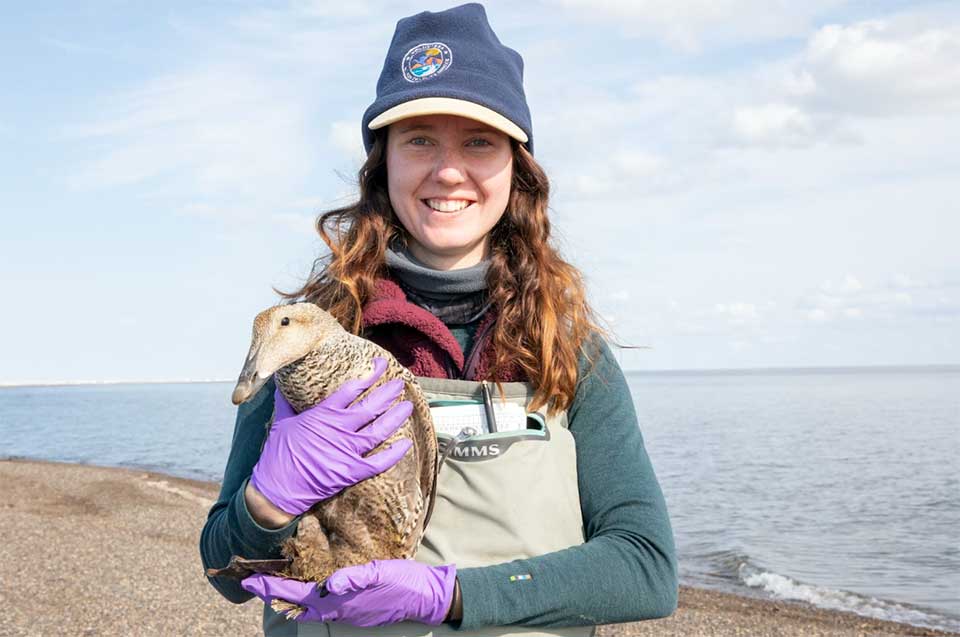Annie Maliguine is a soon-to-be graduate from the College of Fisheries and Ocean Sciences at the University of Alaska Fairbanks. She grew up in Sacramento California and pursued her bachelor’s degree in Wildlife, Fish, and Conservation Biology at UC Davis. It was there, through her coursework and field experience under Dr. John Eadie, that she had her first introduction to sea ducks and waterfowl.

Annie while she was helping on a Common Eider project in Prudhoe Bay for the Arctic NWR. Photo: USFWS/Lisa Hupp
Annie began to help with Dr. Eadie’s Wood Duck studies on brood parasitism, checking nest boxes and tagging hens and ducklings. She was sponsored to attend a hunting camp with the California Waterfowl Association, where each year students learn about hunting safety and practices and join a hunt with experienced hunters. Through these diverse experiences, she quickly realized she wanted to pursue additional work with waterfowl.

Annie helping on a Common Eider project in Prudhoe Bay for the Arctic NWR. Photo: USFWS/Lisa Hupp
After graduating, she supported various waterfowl-related research projects – including monitoring Northern Pintail and Aleutian Cackling Geese with the California Department of Fish and Wildlife, performing breeding and nest surveys on eiders in Utqiagvik, and working at the Arctic National Wildlife Refuge where she conducted nest searches for shorebirds, eiders, and other waterfowl – just to name a few. Her work has taken her all over Alaska, to Utqiaġvik, Izembek Lagoon, Prudhoe Bay, and Demarcation Bay, and she’s had the opportunity to work with all four species of eiders. This incredible array of field experiences ultimately helped her connect with her current advisor at UAF, Dr. Tuula Hollmen, helping study the molting ecology of Steller’s Eiders and collecting benthic samples at Izembek Lagoon.
Her graduate research and her SDJV fellowship research focused on foraging habitat for molting Steller’s Eiders at Izembek Lagoon, a sea duck key habitat site, where she compared changes in benthic prey availability over time. Molting is a stressful event for birds, so molt site selection and the resources there are important, as the eiders are flightless for about a month. In the 1980s, Izembek Lagoon hosted between 30,000 and 60,000 Steller’s eiders each fall, but these numbers have declined to around 5,000 eiders per year, leaving many questioning what is causing the shift. Annie’s research investigated habitat-related changes that may explain the observed reductions in eider numbers at Izembek Lagoon.
After graduating, Annie hopes to continue working with sea ducks. Her ideal career? A job as a biologist, working on eider or sea duck conservation. In the next month, she will begin a short-term position working with the USFWS in Fairbanks as a research technician in the Endangered Species Recovery Program which focuses on listed Spectacled and Steller’s Eiders. She’d also like to continue her research on Steller’s Eiders and foraging during molt in different locations, to compare to Izembek.

Annie while conducting habitat sampling work at Izembek Lagoon. Photo courtesy of Annie Maliguine.
Annie shared that the SDJV student fellowship was particularly impactful for her research because of the flexibility it offered. The fellowship allowed her to use the funds to support the portions of her research that needed it most, including her stipend and travel for fieldwork and community outreach. When asked about what advice she has for current students and those looking to study sea ducks, she said “Stay connected with colleagues and past professors and mentors” and “Be open to working on different projects.”
Steller’s eiders feed on bivalves, snails, and crustaceans when at Izembek. She found a lower biomass of benthic prey when compared to a previous benthic survey conducted in 1998, as well as significantly smaller prey overall. While direct causes are difficult to determine without longer-term data, she believes the reductions in prey biomass and size may be related to warming ocean waters and reduced winter sea ice cover of the lagoon, which can impact the ability of the benthic prey to survive. In turn, this impacts the eiders and may explain the massive decrease in numbers observed at Izembek.
